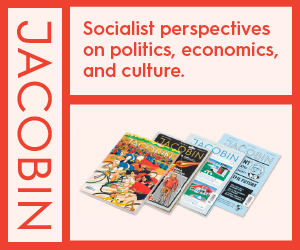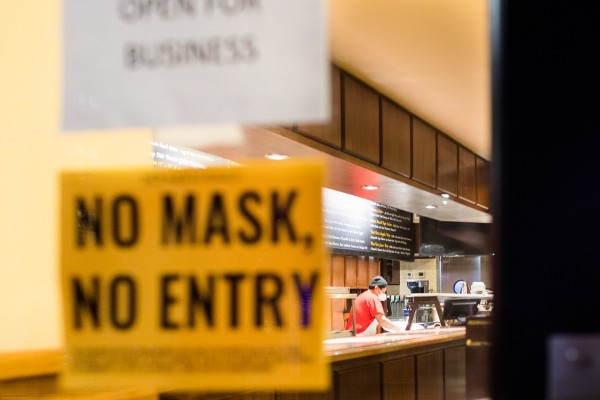Wages did not cause Canada’s inflation crisis
The ‘wage-price spiral’ is a myth told to frighten workers out of threatening profit

Political cartoon published July 7, 1894 by the Chicago Labor newspaper showing the condition of the labouring man at the Pullman Company. The employee is being squeezed by Pullman between low wage and high rent. Image from Wikimedia Commons.
After several successive interest rate shocks by the Bank of Canada, inflation has fallen from over six percent down to 2.8 percent and a recession is probably on the horizon.
Whether or not inflation falls back to trend, it is clear that workers will bear the brunt of the crisis—either through price hikes or wage and job cuts.
Falling inflation, shrinking economy
Last week, Statistics Canada reported that inflation fell to 2.8 percent in June. That’s down significantly from the eye-popping peak of 8.1 percent reached last summer—but it has come at an obvious cost.
After a relaxation of the rate hikes from March to May, the Bank of Canada has now increased its benchmark interest rate from 4.5 to five percent, its highest since 2001. As CIBC Deputy Chief Economist Benjamin Tal says, the bank had a decision to make: “Inflation or a recession.” The bank made its choice. More than 100,184 Canadians have already filed for insolvency in 2022, an 11.2 percent increase from the previous year. And more bankruptcies are coming.
Conference Board of Canada Chief Economist Pedro Antunes has already warned that the future is bleak. “We have essentially no growth in GDP for the next three quarters,” he said. “In this scenario we would see around 163,000 job losses, peak to trough, including those we’ve suffered over the last few months.”
In a Financial Post article titled, “The Bank of Canada may rue its recent interest rate hike,” economist David Rosenberg says a new rate hike will be the “nail in the coffin that will bury Canada’s debt-heavy economy.”
To what degree these hikes will actually reduce inflation is an open question. While the government’s combined deficit-financed corporate bailouts and quantitative easing schemes (which together increased the money supply by up to 30 percent) had a devaluing effect, the trend is more complicated. The increase in the supply of money as a means of exchange combined to raise prices to decade-highs, even threatening stagflation. This has been exacerbated by post-pandemic supply chain woes, protectionism, and a war in Eastern Europe.
“Turning off the taps” by massively raising the cost of credit will certainly slow spending domestically. But it will not change the international dynamics or even increase the scale of production.
Workers are not to blame
Throughout both the inflationary spikes and the Bank of Canada’s successive rate hikes, Governor Tiff Macklem did everything he could to blame workers for the crisis.
In late 2022, as inflation approached eight percent, Macklem advised the country’s lords of industry to do all they could to resist cost of living adjustments (increases in wages at specified intervals).
According to the governor, these adjustments merely create “a self-perpetuating cycle… as businesses don’t build that into longer-term contracts; don’t build that into wage contracts. It is going to take some time, but you can be confident that inflation will come down.”
The argument put forward by Macklem—the risk of a “wage-price spiral”—is not new, even though it has never been proven.
The basic idea, in its most intelligent form, claims to track “the inflationary pressures generated by changes in the distribution of income between and within all economic groups.” Put less intelligently, Macklem said in April 2023, amid one of Canada’s largest strikes: “Wage growth has been running at four to five percent and unless there’s a surprising acceleration in productivity, that’s not consistent with two percent inflation.”
The basic theory is that if wages go up, the nation’s bosses have no choice but to compensate for those wage increases except by hiking their prices—“passing them on” to the same workers. Those workers, in turn, react by demanding new wage increases.
Just as Macklem was calling for workers to accept wage cuts, the federal government’s Parliamentary Budget Office (PBO) disputed the correlation. In June 2022 it noted that while wages had risen 8.6 percent since the onset of the pandemic, inflation had climbed nine percent. “To date, wage settlements data also show little indication of higher observed and expected inflation feeding into wage negotiations,” PBO said in a statement.
By April 2023, there was still no observable trend. In the middle of the Public Service Alliance of Canada (PSAC) strike in April which saw 120,000 public servants walk off the job, Unifor economist Kaylie Tiessen similarly told CBC News that, despite continuing claims from Macklem and other corporate economists, Canada’s rising inflation was not correlated strongly with wage growth.
“The share of GDP that labour is taking home compared to the share of GDP that capital is taking home—the gap is increasing and has increased over time,” Tiessen told CBC. “Workers are not taking home as much of what is produced in Canada and that leads to higher inequality and leads to a number of negative economic effects as well.”
According to a study by professor Murray Smith, through the 1970s, when wage gains and price gains mapped more closely, wages as a share of output fell. In 1970, the ratio of surplus value to variable capital or the rate of exploitation was 0.6297. By 1972 it was up to 0.6825, by 1976 it climbed to 0.8192, and by 1978 it stood at 0.8147. This marks, he observes, “a dramatic increase in the rate of surplus value (rate of exploitation) in the Canadian economy.”
More recently, the International Monetary Fund (IMF), The Economist magazine, and others have had to concede that there is not anywhere any real empirical evidence of such a “spiral.” As The Economist admitted, “rising salaries are a poor predictor of future inflation.”
Beyond the empirical
Beyond the empirical, the wage-price spiral model makes little sense logically.
If these firms could set prices as they like, there is little reason for them to fight to lower wages or worry about competition in general. There are certainly some firms that can charge monopoly prices, but this does not explain general inflation.
Beyond price-setting, as a recent survey by Canada’s food services lobby Restaurants Canada notes, workers are not paid the full value of their output—otherwise there would be little to no profit. In the restaurant and hospitality industry “labour costs” consume around 30 percent of total sales.
According to economist Jim Stanford, this insight generally applies to other sectors across Canada. “Labour costs make up only one-third of direct production costs, on average, across all industries,” he says. It is these same industries that have seen their “already-swollen” profit grow. And yet, it is argued that wages cause price hikes.
The model also treats the price and profit system as an additive relationship, whereby wages or variable capital, constant capital, and profits all add up to the price of the good on hand. In reality, it is a subtractive one. The workers transform their material into finished goods and a portion of the value they produce is unpaid—it is instead delivered to their boss as profit.
Marx dealt with these questions at least twice, in The Poverty of Philosophy (1847) and then in Value, Price and Profit (1865). In the latter, a polemic against Ricardian socialist John Weston, Marx draws the insightful analogy to a bowl of soup:
Weston illustrated his theory by telling you that a bowl contains a certain quantity of soup, to be eaten by a certain number of persons, an increase in the broadness of the spoons would produce no increase in the amount of soup. He must allow me to find this illustration rather spoony. It reminded me somewhat of the simile employed by Menenius Agrippa. When the Roman plebeians struck against the Roman patricians, the patrician Agrippa told them that the patrician belly fed the plebeian members of the body politic. Agrippa failed to show that you feed the members of one man by filling the belly of another. Citizen Weston, on his part, has forgotten that the bowl from which the workmen eat is filled with the whole produce of national labour, and that what prevents them fetching more out of it is neither the narrowness of the bowl nor the scantiness of its contents, but only the smallness of their spoons.
Wages do not cause inflation but they do eat into profits. And profit, the unpaid labour of the working class, is the lifeblood upon which all the parasitic layers of society depend—from bosses to central bankers. The wage-price spiral is not a serious model; it’s a tale told to frighten workers out of threatening profit.
Ultimately, it is hard to tell how high interest rates will go and how deep the next recession will be. But it is clear that business will be bailed out in the end. And, as usual, workers will be forced to suffer the cost after earlier bearing the brunt of inflation. As the Toronto Star put it, the future, on the basis of capitalism, will be one of “Low productivity growth and stagnant real wages.”
Mitchell Thompson is a writer, editor and occasional radio producer based in Toronto.










